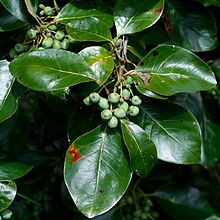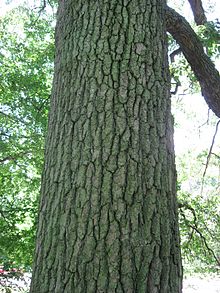Nyssa sylvatica
This article needs additional citations for verification. (June 2010) |
| Tupelo | |
|---|---|

| |
| Foliage and almost mature fruit | |
| Scientific classification | |
| Kingdom: | Plantae |
| Clade: | Tracheophytes |
| Clade: | Angiosperms |
| Clade: | Eudicots |
| Clade: | Asterids |
| Order: | Cornales |
| Family: | Nyssaceae |
| Genus: | Nyssa |
| Species: | N. sylvatica
|
| Binomial name | |
| Nyssa sylvatica Marshall
| |

| |
| Natural range | |
Nyssa sylvatica, commonly known as tupelo, black tupelo, blackgum or sour gum,[2] is a medium-sized deciduous tree native to eastern North America from the coastal Northeastern United States and southern Ontario south to central Florida and eastern Texas, as well as Mexico.
Names
Nyssa sylvatica's genus name, Nyssa, refers to a Greek water nymph;[3] the species epithet sylvatica refers to its woodland habitat.[3]
The species' common name, tupelo, is of
While these trees are often known as simply "
In Appalachia, the frequent variant is Nyssa sylvatica var. caroliniana, which is sometimes called the Yellow Gum. Its leaflets are thinner and less glossy, "with rather long tips, the under surface persistently somewhat downy and covered with minute warty excrescences easily seen under an ordinary hand lens"[5] "Yellow Gum is not a swamp tree, like Black Gum, but an inhabitant of dry land, hills, and the coves of the southern Appalachians which it ascends to 3500 feet.[5]
On
Description


Nyssa sylvatica grows to 20–25 metres (66–82 ft) tall, rarely to 35 metres (115 ft), with a trunk diameter of 50–100 centimetres (20–39 in), rarely up to 170 centimetres (67 in). These trees typically have a straight trunk with the branches extending outward at right angles.[3] The bark is dark gray and flaky when young, but it becomes furrowed with age, resembling alligator hide on very old stems. The twigs of this tree are reddish-brown, usually hidden by a greyish skin. The pith is chambered with greenish partitions.
The leaves of this species are variable in size and shape. They can be oval, elliptical, or obovate, and 5–12 cm (2–4.5 in) long. They have lustrous upper surfaces, with entire, often wavy margins. The foliage turns purple in autumn, eventually becoming an intense bright scarlet. Deer are extremely fond of the leaves on seedlings and saplings, to the point where large populations of them can make establishment of the tree almost impossible. For comparison, mature trees are largely left alone.
The
Nyssa sylvatica forms a large deep taproot when young that makes transplanting difficult. Because of this, it is fairly uncommon in cultivation and the nursery trade.
Additional characteristics include:
- Bark: Light reddish brown, deeply furrowed and scaly. Branchlets at first pale green to orange, sometimes smooth, often downy, later dark brown.
- Wood: Pale yellow, sapwood white; heavy, strong, very tough, hard to split, not durable in contact with the soil. Used for turnery. Sp. gr., 0.6353; weight of cu. ft., 39.59.
- Winter buds: Dark red, obtuse, one-fourth of an inch long. Inner scales enlarge with the growing shoot, becoming red before they fall.
- Leaves: Alternate, often crowded at the end of the lateral branches, simple, linear, oblong to oval, two to five inches (127 mm) long, one-half to three inches (76 mm) broad, wedge-shaped or rounded at base, entire, with margin slightly thickened, acute or acuminate. They come out of the bud conduplicate, coated beneath with rusty tomentum, when full grown are thick, dark green, very shining above, pale and often hairy beneath. Feather-veined, midrib and primary veins prominent beneath. In autumn they turn bright scarlet, or yellow and scarlet. Petioles one-quarter to one-half an inch long, slender or stout, terete or margined, often red.
- Flowers: May, June, when leaves are half grown. Polygamodiœcious, yellowish green, borne on slender downy peduncles. Staminate in many-flowered heads; pistillate in two to several flowered clusters.
- Calyx: Cup-shaped, five-toothed.
- Corolla: Petals five, imbricate in bud, yellow green, ovate, thick, slightly spreading, inserted on the margin of the conspicuous disk.
- Stamens: Five to twelve. In staminate flowers exserted, in pistillate short, often wanting.
- Pistil: Ovary inferior, one to two-celled; style stout, exserted, reflexed above the middle. Entirely wanting in sterile flower. Ovules, one in each cell.
- Fruit: Fleshy drupe, one to three from each flower cluster. Ovoid, two-thirds of an inch long, dark blue, acid. Stone more or less ridged. October.[7]
Distribution
Nyssa sylvatica grows in various uplands and in alluvial stream bottoms from southwestern Maine and New York, to extreme southern Ontario, central Michigan, Illinois, and central Missouri, south to southern Florida, eastern Texas, and eastern Oklahoma.[8] Optimum development is made on lower slopes and terraces in the Southeastern United States.[9] It also occurs locally in the mountains of eastern and southern Mexico, where it is found in the southern Sierra Madre Oriental and Sierra Madre de Oaxaca of Hidalgo, Puebla, and Veracruz states and the Chiapas Highlands of Chiapas.[10]
Ecology
Nyssa sylvatica is found in a variety of upland and wetland habitats in its extensive range. Its flowers are an important source of nectar and its fruits are important to many birds and mammals.[11] Hollow trunks provide nesting or denning opportunities for bees and various mammals. It is the longest living non-clonal flowering plant in Eastern North America, capable of obtaining ages of over 650 years.[12]
Habitats
Nyssa sylvatica is found in a wide range of climates, due to its extensive distribution. It commonly grows in both the creek bottoms of the southern coastal plains, to altitudes of about 900 meters (3,000 feet) in the Southern Appalachians. These trees grow best on well-drained, light-textured soils on the low ridges of second bottoms and on the high flats of silty alluvium. In the uplands it grows best on the loams and clay loams of lower slopes and coves.
The species occurs 35 different forest cover types.[9] When found on drier upper slopes and ridges, it is seldom of log size or quality.[9]
In Mexico it is a common species in montane cloud forests, particularly in moist or riparian habitats, between 1,000 and 2,200 meters elevation.[10]
Wildlife

Nyssa sylvatica is an important food source for many migrating birds in the fall [autumn]. Its early color change (
] all primarily eastern North American birds migrating or residing year-round within the tree's range.The limbs of these trees often deteriorate early, and the decayed holes make excellent dens for
The leaves are
Uses

Cultivation
Nyssa sylvatica is cultivated as an
The leaves are short-petioled and so have little individual motion, but the branches sway as a whole. The spray is fine and abundant and lies horizontally so that the foliage arrangement is not unlike that of the
In the UK the cultivar 'Wisley Bonfire' has gained the Royal Horticultural Society's Award of Garden Merit.[14][15]
Honey production
Nyssa sylvatica is a major source of wild honey in many areas within its range. Hollow sections of black gum trunks were formerly used as bee gums by beekeepers.[16]
Wood
The wood of Nyssa sylvatica is heavy, hard, cross-grained, and difficult to split, especially after drying. This resistance to splitting led to its use for making
Teeth-cleaning twig
It was also used traditionally by Native Americans as a teeth-cleaning twig.[18] It also was used for dipping snuff.
References
- . Retrieved 11 November 2021.
- ^ "Tupelo, Black gum, sour gum - Nyssa sylvatica". University of Copenhagen. 29 September 2010. Retrieved May 15, 2018.
- ^ a b c d e f g Werthner, William B. (1935). Some American Trees: An intimate study of native Ohio trees. New York: The Macmillan Company. pp. xviii + 398 pp.
- ^ New Oxford American Dictionary, 2nd Edition.
- ^ ISBN 978-0-395-58174-2. Retrieved 14 September 2020.
- ^ Paxton, William C. (2014). "Why Do They Call It a Gum Tree?". Penn State Extension. Retrieved 2014-09-14.
- ^ a b Keeler, Harriet L. (1900). Our Native Trees and How to Identify Them. New York: Charles Scribner's Sons. pp. 186–189.
- ^ Coladonato, Milo 1992. Nyssa sylvatica. In: Fire Effects Information System, [Online]. U.S. Department of Agriculture, Forest Service, Rocky Mountain Research Station, Fire Sciences Laboratory. Retrieved 2012-09-30.
- ^ a b c “Black Tupelo” US Forest Service. Retrieved 2012-09-30.
- ^ ISBN 9781903703281
- ISBN 0-394-50760-6.
- ^ http://www.ldeo.columbia.edu/~adk/oldlisteast/#spp Eastern OLDLIST
- ISBN 978-0160292606. Agriculture Handbook 654. Retrieved 5 October 2022.
- ^ "RHS Plantfinder - Nyssa sylvatica 'Wisley Bonfire'". Retrieved 4 April 2018.
- ^ "AGM Plants - Ornamental" (PDF). Royal Horticultural Society. July 2017. p. 69. Retrieved 13 April 2018.
- ISBN 9781136746697.
- ^ Pages 12 & 26 "The Tie Guide 2nd edition (2016)" Prepared for the Railway Tie Association (RTA) by David A. Webb and Geoffrey V. Webb
- ^ "Tupelo (Blackgum, Sourgum)". University of Arkansas. Retrieved 20 October 2020.

